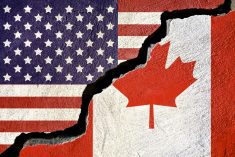One word — relief — summed up the completion of a new trade pact to replace the North American Free Trade Agreement. Agricultural leaders in Canada, the U.S. and Mexico all breathed deep sighs of relief after the three countries signed the new U.S.-Mexico-Canada Agreement. That’s because the new pact leaves intact all the elements of NAFTA that made North America a fully integrated market for cattle, hogs, beef and pork.
Read Also

What to know before you go to Agribition 2025
If you’re attending Agribition 2025, this is the place to find out about tickets, dates and what’s happening this year.
Signed in 1994, NAFTA reshaped North American economic relations in a way that few people imagined at the time. In the past 24 years, U.S. farmers and growers have quadrupled their exports to Canada and Mexico, and the two nations rank second and third after China as the top markets for U.S. farm goods. That’s why ag leaders fought hard to convince the Trump administration to strike a new deal and not blow up NAFTA, as President Trump had threatened to do.
As you know, Canada was forced to open its dairy market to more U.S. milk, cream, and butter, while curbing subsidies for its dairy exports. The concession will grant the U.S. access to 3.6 per cent of Canada’s dairy market. This might not seem like much but any dairy concessions had been strongly opposed in parts of Canada, notably in Quebec. Canadian Prime Minister Justin Trudeau admitted the dairy concessions were not ideal and pledged to fully compensate Canadian dairy farmers for any loss of market share related to the new pact.
The new pact, though, did not address the tariffs imposed on U.S. food products by Mexico and Canada as part of the trade war between the three countries. U.S. pork to Mexico has faced a new 20 per cent tariff for several months, while U.S. cheese faces 20 per cent to 25 per cent tariffs. On July 1 Canada imposed US$170 million of tariffs on cooked beef products. It is the U.S.’s largest market for these items so the tariffs will have an impact on some meat companies’ business. Canada’s beef tariffs were part of a package of $12.6 billion worth of retaliatory tariffs on a wide range of U.S. goods.
The categories of beef items subject to tariffs included beef jerky, cooked meatloaf, meatballs, beef pies, stews, ground cooked beef, snack packs with meat, and mixed meat TV-style dinners. Fresh and frozen unprocessed beef-cuts and offal were not affected. Certain processed products like beef sausages, corned beef or beef liver products were also not covered.
Fortunately for the U.S. beef industry, exports have boomed so far this year and set a new monthly value record in August, although they softened somewhat after that. August exports topped US$750 million for the first time and muscle cut exports set a new volume record for the third consecutive month. For January through August, U.S. beef exports totaled 899,300 metric tonnes, up nine per cent from a year ago, while value climbed 18 per cent to US$5.51 billion.
Export growth also fueled the Certified Angus Beef (CAB) brand to another record year in terms of sales volume. CAB reported sales of 1.21 billion pounds in fiscal 2018 ending September 30. This was an 8.1 per cent increase on 2017 and was the third year of one billion plus sales in the brand’s 40-year history. The most explosive growth took place in CAB’s international division, with 207 million pounds exported to 50 countries. This was an 18.6 per cent increase over last year and the best in the brand’s history, it says. This was due to the strong market in South Korea, followed by Canada, Japan, Hong Kong and Mexico, says CAB.
















